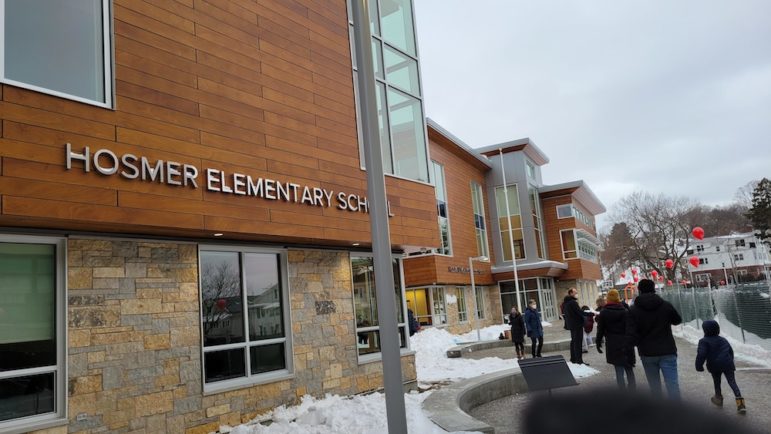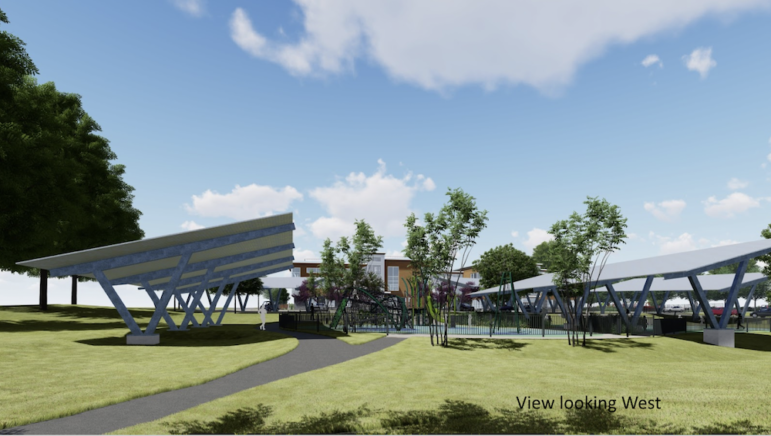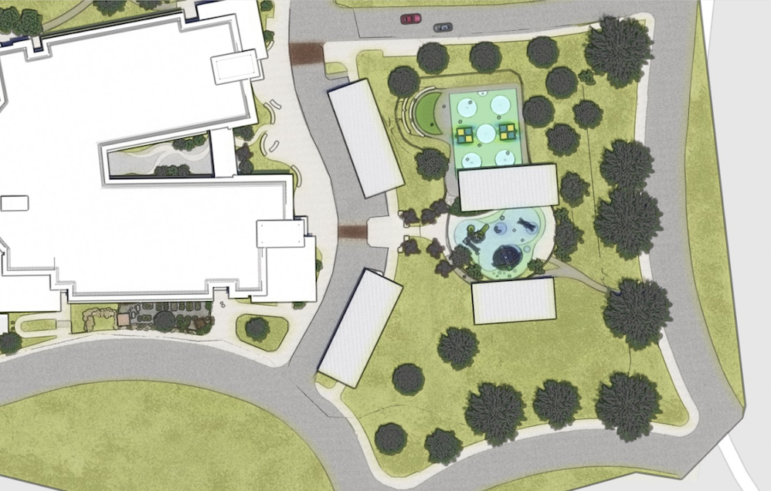
Charlie Breitrose The new Hosmer School opened in February but the old section still stands. It will be soon be deomolished.
The brand new Hosmer Elementary School recently opened its doors, but the main classroom building of the old one remains standing. It will soon be torn down and it will have some impacts on the neighborhood, including cutting off water for a period.
Tom Finnegan from Hill International told the School Building Committee on Wednesday that the demolition of the old building will soon begin.
“Asbestos abatement of the Z Section (the old building) has been completed,” Finnegan said. “We are currently getting all the utilities disconnected and signed off, and the demolition permit is in the works. We hope to start demolition by late April.”
Part of the utility work will include cutting off the water supply, which will require shutting down the water in the neighborhood near the school
“We need to disconnect the water to the Z section. It requires us to cut back to the main, shut the main off. It will disrupt water to a few neighbors,” Finnegan said. “They will cut out a section of pipe and put a new section of pipe in and turn water back on. It will probably be late at night. It will be scheduled in the evening and (water will) be on by morning.”
Finnegan said the work will likely take place the week of April 25, and neighbors should get notification at least 48 hours ahead of time.
The demolition of the old Hosmer will take about two months, Finnegan said. Taking down the building will take about three to four weeks, and another month will be spent cleaning up the debris and removing the foundation.
School Building Committee member Leo Patterson asked what measures would be taken to prevent dust from spreading into the neighborhood. Finnegan said that fire hoses would wet down the debris as the building is torn down.
Over the summer, after the school is torn down, other work on the site will take place, Finnegan said. He added that the big piles of dirt on O’Connell Field will begin to disappear after the building is demolished. Some will be used as in-fill for the area where the building was located, and some will be used to grade O’Connell Field.
Finnagen said the goal is to sod the playing field by Sept. 15.
Solar Panels

Ai3 Architects A rendering of what the solar photovoltaic panels would look like near the play areas planned next to Hosmer School. The view is looking west from Chauncey Street.
The School Building Committee continued discussing where to place two arrays of solar photovoltaic (PV) panels that had originally been proposed to be put near Hancock Street. Nearby neighbors opposed that location because they said they would be too close to their home and be 22-feet tall at the highest point.
Designers from Ai3 showed a proposal to put them next to a play structure and a sports court on the same grassy area. Ultimately the Committee asked for more options for locations of the PV arrays.
Some committee members liked the general idea of putting them near the playgrounds, but worried about them being too close to the play areas. City Council Vice President Vincent Piccirilli said one of the arrays hung over the sports court, and asked if the court could be moved so it was not covering that area. Heidi Perkins, the Watertown Schools’ Director of Finance and Operations, was concerned that the ran and snow would come off the panels onto the play areas and make them unusable after storms.
Assistant Town Manager Steve Magoon said he would be afraid of the panels being damaged by kids throwing balls up on the panels. The slope of the arrrays would provide a good “ball return,” he said.
School Building Committee member Paul Anastasi said he liked the idea of the panels being next to the play area because they provided shade. He said he is a skin cancer survivor and that it is important to provide shelter from the sun.
Ai3 Architects
An overhead look at the placement of the solar photovoltaic arrays next to Hosmer School. In this plan the two arrays on the right are next to a sports court and a play structure. Suggestions were made to move then near the other two arrays on the left side, or to other parts of the area. Originally they were proposed to go along Hancock Street (the short road along the top with the two cars).
Others suggested moving the solar arrays to other areas of that section of the property, or even to other parts of the Hosmer site. One suggestion that multiple people liked was to put them between two larger arrays that run along the driveway. That would get them out of the play area and would provide shade and rain cover for a pathway from the school to the green space.
Suggestions from Committee members and the public also included looking at putting the panels on the side of Hosmer facing Mt. Auburn Street, near the other panels already standing over the parking area at the corner of Boylston Street and Mt. Auburn Street, or even on top of the bathrooms to be built on O’Connell Field.
The designers were asked why the particular design of the structure holding the panels was shown in the renderings. Daren Sawyer of Ai3 Architects said the steel structure has already been fabricated and is on site, as are the PV panels.
City Council President Mark Sideris, who chairs the Building Committee, asked designers to consider multiple options, and not be limited by what they have now.
“I know we have things purchased, but you shouldn’t do something just because you have purchased them,” Sideris said.
Designers will come back to the Committee at a future meeting with more options for places to put the solar arrays.
Hurray! Paul Anastasia -you are thinking about all of us in the hot, damaging sun. I have been out on the playground last summer and saw several parents standing against the wall to get some relief. Shade is what we need for the children, teachers, and the rest of us!
Please please PLEASE we beg you—not so familiar with this school but whatever you do—do not remove beautiful mature trees at this site for this development project!! We are all for net zero and solar panels… But we live on Grandview Avenue behind Cunniff school. In order for these solar panels to be put up, an ENTIRE ROW OF HUGE MATURE beautiful trees that were providing shade to ALL of our backyards AND to the school were completely demolished!!!! How does this make for a truly net zero design?? It DOESN’T. How about TREES for kids to play under for shade instead of industrial solar panels?? —-I mean We are OK with solar panels— as long as the plan is NOT to remove existing trees to put them up! The removal of all of our trees behind Grandview really affected all of our backyards and outdoor space and negatively impacted the entire street of residents —and our backyard ecosystems— and could have/should have been preserved to keep providing for the school— we think it was a real loss—Another design where the solar panels were installed somewhere else would’ve made totally more sense —perhaps the roof of the school? Cutting down trees for solar should be an obvious flag that an alternative design should be considered. Thank you.
I think it’s a little late for that. Several large healthy trees were already cut down around the school and field when construction started two years ago. And not one person complained. Yet if a home owner wants to cut down a tree on his property to maybe prevent it from falling on their house, the town wants to crucify them.
Jenny Smith: Thank you for taking the time to explain the impact on your family, your Grandview Ave neighbors and Cunniff School of removal of this row of mature trees to make way for solar panels.
Our city destroyed an important neighborhood asset for managing climate change when they permitted destruction of those neighborhood shade trees. Mature urban shade trees play a key role in tempering the punishing effects of soaring summer temperatures, both by intercepting solar radiation that would otherwise heat up city hardscape like an oven, and by the process of transpiration which makes every tree a living air conditioner.
Moreover a mature shade tree can absorb thousands of gallons of storm water annually. This impressive natural capacity is increasingly important as rainfall increases in New England.
The public health benefits of urban tree canopy are well documented in public health literature. Any parent will agree who has blessed the cooling shade of a park tree on a hot summer day while they watched their children play.
These important infrastructural services, along with the other community and environmental benefits you feelingly describe the loss of with the loss of the row of trees behind Grandview Ave homes, are why every Watertown development plan should prioritize preservation of shade trees as a community asset and front-line climate defense.
An urban forest with trees with a range of ages is a healthy urban forest. Watertown is planting new street trees each year, is asking developers to include new shade trees in their plans, and will be encouraging residents to plant new shade trees on their properties.
Thoughtful new plantings are tremendously important to ensure Watertown has protective tree canopy in the future. But preservation of existing healthy trees is arguably even more important. Young trees take decades to replace the services of existing mature shade trees.
Thank you again for your important comment. I hope it has an impact. If you haven’t yet, please consider sharing it with our City Council by emailing citycouncilors@watertown-ma.gov.